CHEVROLET COLORADO 2007 1.G Owners Manual
Manufacturer: CHEVROLET, Model Year: 2007, Model line: COLORADO, Model: CHEVROLET COLORADO 2007 1.GPages: 496, PDF Size: 2.7 MB
Page 371 of 496
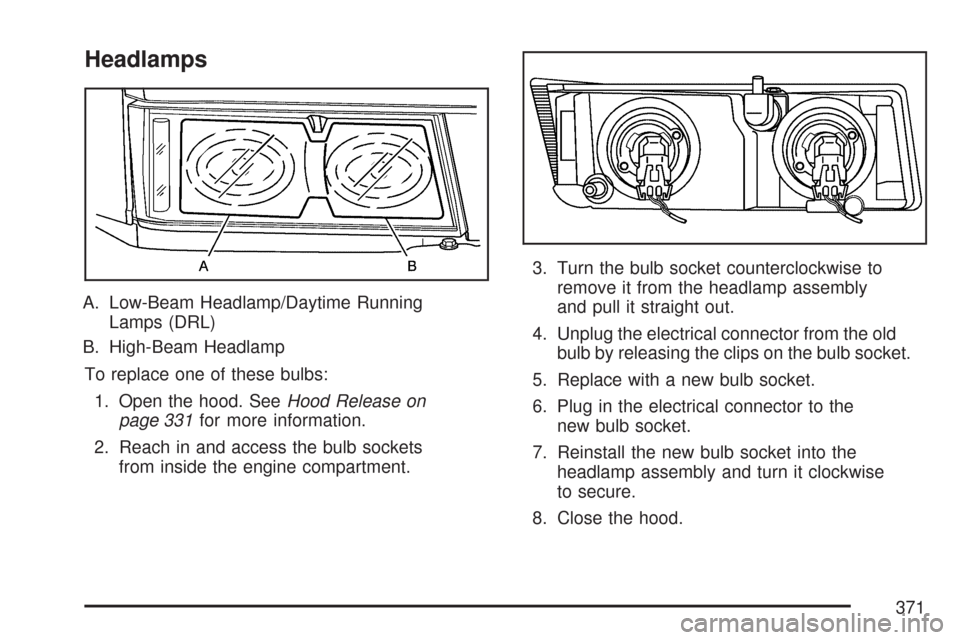
Headlamps
A. Low-Beam Headlamp/Daytime Running
Lamps (DRL)
B. High-Beam Headlamp
To replace one of these bulbs:
1. Open the hood. SeeHood Release on
page 331for more information.
2. Reach in and access the bulb sockets
from inside the engine compartment.3. Turn the bulb socket counterclockwise to
remove it from the headlamp assembly
and pull it straight out.
4. Unplug the electrical connector from the old
bulb by releasing the clips on the bulb socket.
5. Replace with a new bulb socket.
6. Plug in the electrical connector to the
new bulb socket.
7. Reinstall the new bulb socket into the
headlamp assembly and turn it clockwise
to secure.
8. Close the hood.
371
Page 372 of 496
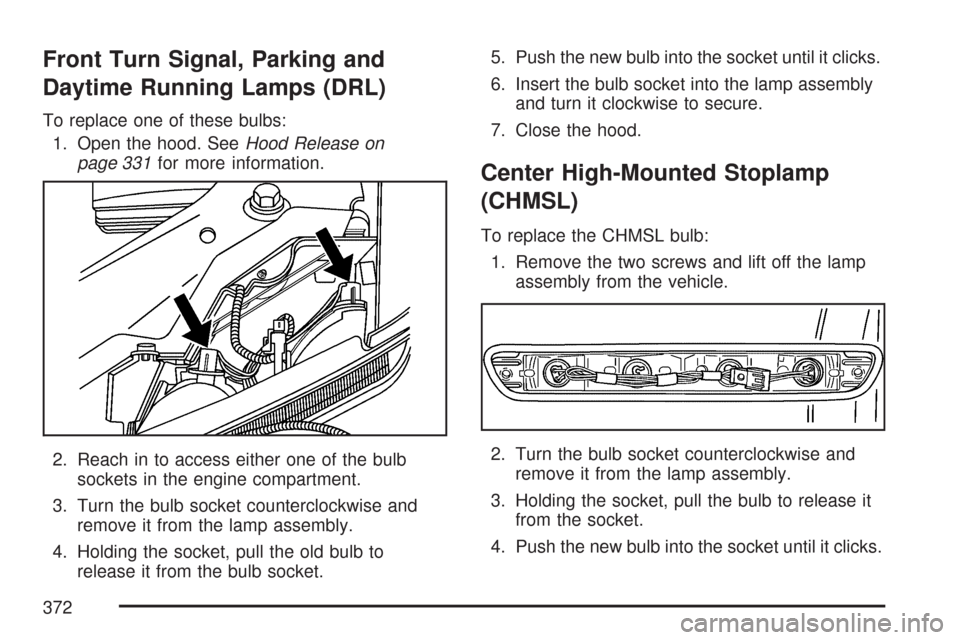
Front Turn Signal, Parking and
Daytime Running Lamps (DRL)
To replace one of these bulbs:
1. Open the hood. SeeHood Release on
page 331for more information.
2. Reach in to access either one of the bulb
sockets in the engine compartment.
3. Turn the bulb socket counterclockwise and
remove it from the lamp assembly.
4. Holding the socket, pull the old bulb to
release it from the bulb socket.5. Push the new bulb into the socket until it clicks.
6. Insert the bulb socket into the lamp assembly
and turn it clockwise to secure.
7. Close the hood.
Center High-Mounted Stoplamp
(CHMSL)
To replace the CHMSL bulb:
1. Remove the two screws and lift off the lamp
assembly from the vehicle.
2. Turn the bulb socket counterclockwise and
remove it from the lamp assembly.
3. Holding the socket, pull the bulb to release it
from the socket.
4. Push the new bulb into the socket until it clicks.
372
Page 373 of 496
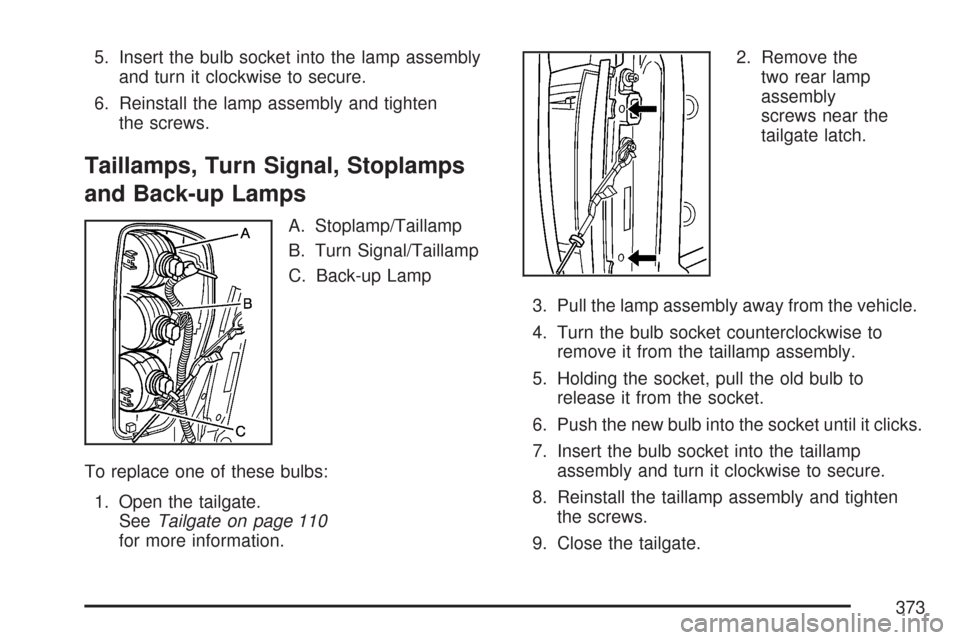
5. Insert the bulb socket into the lamp assembly
and turn it clockwise to secure.
6. Reinstall the lamp assembly and tighten
the screws.
Taillamps, Turn Signal, Stoplamps
and Back-up Lamps
A. Stoplamp/Taillamp
B. Turn Signal/Taillamp
C. Back-up Lamp
To replace one of these bulbs:
1. Open the tailgate.
SeeTailgate on page 110
for more information.2. Remove the
two rear lamp
assembly
screws near the
tailgate latch.
3. Pull the lamp assembly away from the vehicle.
4. Turn the bulb socket counterclockwise to
remove it from the taillamp assembly.
5. Holding the socket, pull the old bulb to
release it from the socket.
6. Push the new bulb into the socket until it clicks.
7. Insert the bulb socket into the taillamp
assembly and turn it clockwise to secure.
8. Reinstall the taillamp assembly and tighten
the screws.
9. Close the tailgate.
373
Page 374 of 496
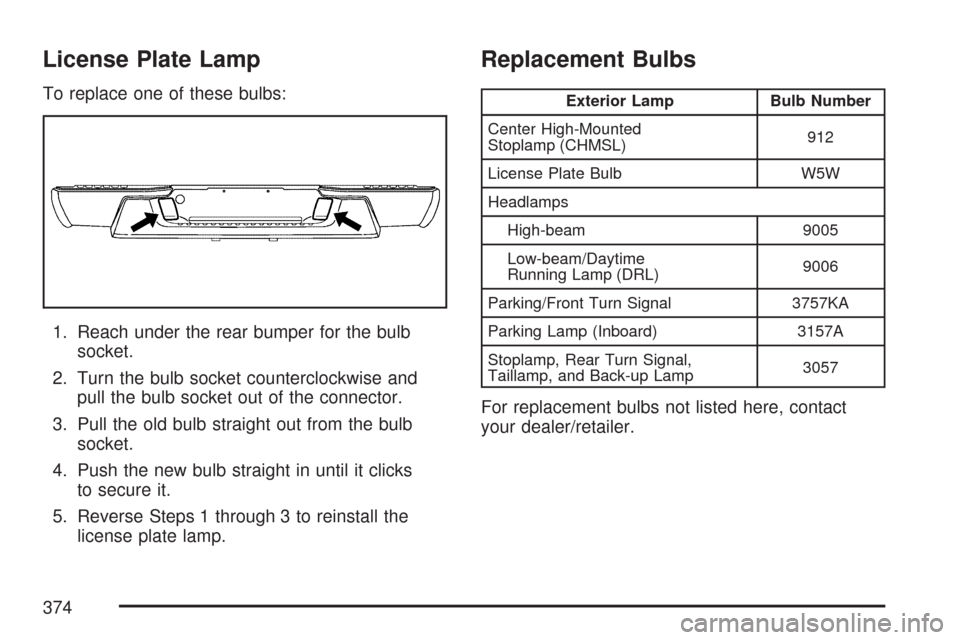
License Plate Lamp
To replace one of these bulbs:
1. Reach under the rear bumper for the bulb
socket.
2. Turn the bulb socket counterclockwise and
pull the bulb socket out of the connector.
3. Pull the old bulb straight out from the bulb
socket.
4. Push the new bulb straight in until it clicks
to secure it.
5. Reverse Steps 1 through 3 to reinstall the
license plate lamp.
Replacement Bulbs
Exterior Lamp Bulb Number
Center High-Mounted
Stoplamp (CHMSL)912
License Plate Bulb W5W
Headlamps
High-beam 9005
Low-beam/Daytime
Running Lamp (DRL)9006
Parking/Front Turn Signal 3757KA
Parking Lamp (Inboard) 3157A
Stoplamp, Rear Turn Signal,
Taillamp, and Back-up Lamp3057
For replacement bulbs not listed here, contact
your dealer/retailer.
374
Page 375 of 496
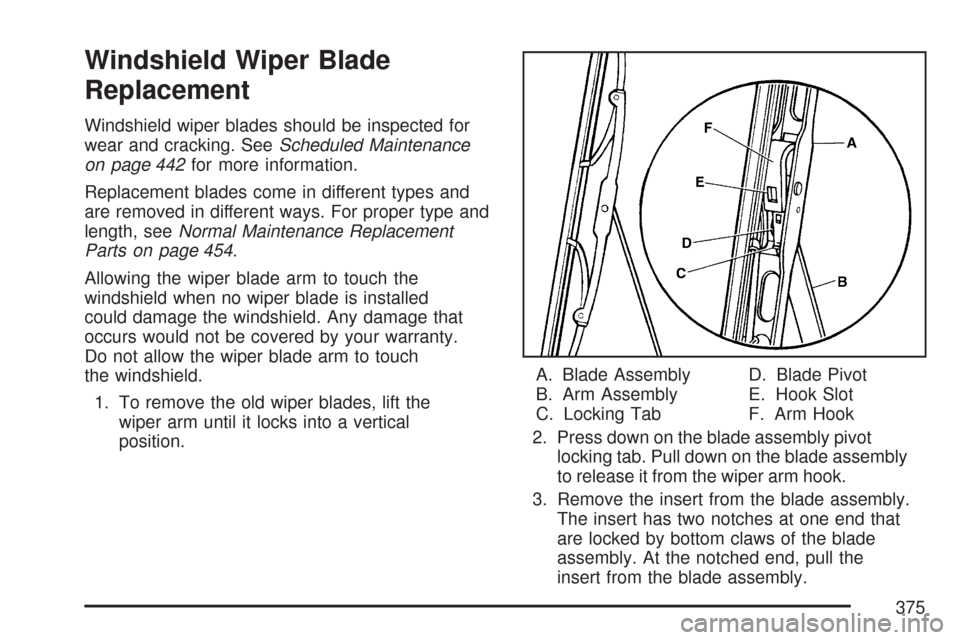
Windshield Wiper Blade
Replacement
Windshield wiper blades should be inspected for
wear and cracking. SeeScheduled Maintenance
on page 442for more information.
Replacement blades come in different types and
are removed in different ways. For proper type and
length, seeNormal Maintenance Replacement
Parts on page 454.
Allowing the wiper blade arm to touch the
windshield when no wiper blade is installed
could damage the windshield. Any damage that
occurs would not be covered by your warranty.
Do not allow the wiper blade arm to touch
the windshield.
1. To remove the old wiper blades, lift the
wiper arm until it locks into a vertical
position.A. Blade Assembly
B. Arm Assembly
C. Locking TabD. Blade Pivot
E. Hook Slot
F. Arm Hook
2. Press down on the blade assembly pivot
locking tab. Pull down on the blade assembly
to release it from the wiper arm hook.
3. Remove the insert from the blade assembly.
The insert has two notches at one end that
are locked by bottom claws of the blade
assembly. At the notched end, pull the
insert from the blade assembly.
375
Page 376 of 496
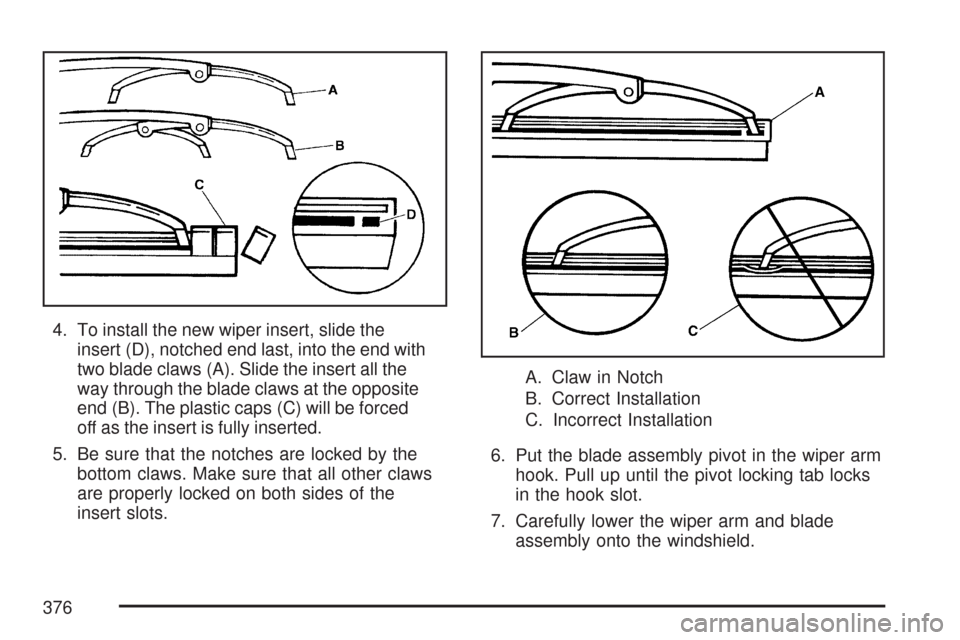
4. To install the new wiper insert, slide the
insert (D), notched end last, into the end with
two blade claws (A). Slide the insert all the
way through the blade claws at the opposite
end (B). The plastic caps (C) will be forced
off as the insert is fully inserted.
5. Be sure that the notches are locked by the
bottom claws. Make sure that all other claws
are properly locked on both sides of the
insert slots.A. Claw in Notch
B. Correct Installation
C. Incorrect Installation
6. Put the blade assembly pivot in the wiper arm
hook. Pull up until the pivot locking tab locks
in the hook slot.
7. Carefully lower the wiper arm and blade
assembly onto the windshield.
376
Page 377 of 496
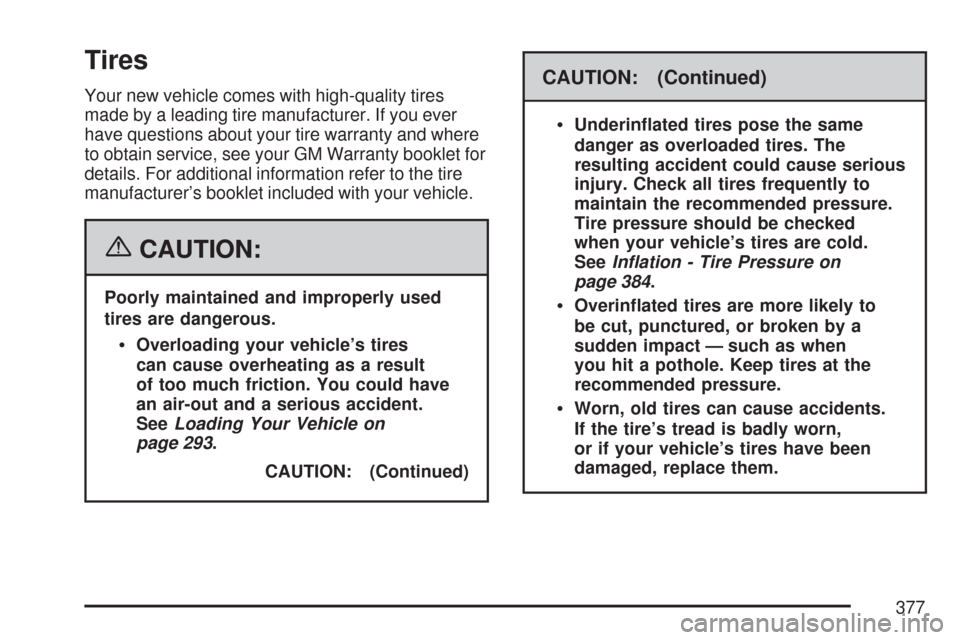
Tires
Your new vehicle comes with high-quality tires
made by a leading tire manufacturer. If you ever
have questions about your tire warranty and where
to obtain service, see your GM Warranty booklet for
details. For additional information refer to the tire
manufacturer’s booklet included with your vehicle.
{CAUTION:
Poorly maintained and improperly used
tires are dangerous.
Overloading your vehicle’s tires
can cause overheating as a result
of too much friction. You could have
an air-out and a serious accident.
SeeLoading Your Vehicle on
page 293.
CAUTION: (Continued)
CAUTION: (Continued)
Underin�ated tires pose the same
danger as overloaded tires. The
resulting accident could cause serious
injury. Check all tires frequently to
maintain the recommended pressure.
Tire pressure should be checked
when your vehicle’s tires are cold.
SeeInflation - Tire Pressure on
page 384.
Overin�ated tires are more likely to
be cut, punctured, or broken by a
sudden impact — such as when
you hit a pothole. Keep tires at the
recommended pressure.
Worn, old tires can cause accidents.
If the tire’s tread is badly worn,
or if your vehicle’s tires have been
damaged, replace them.
377
Page 378 of 496
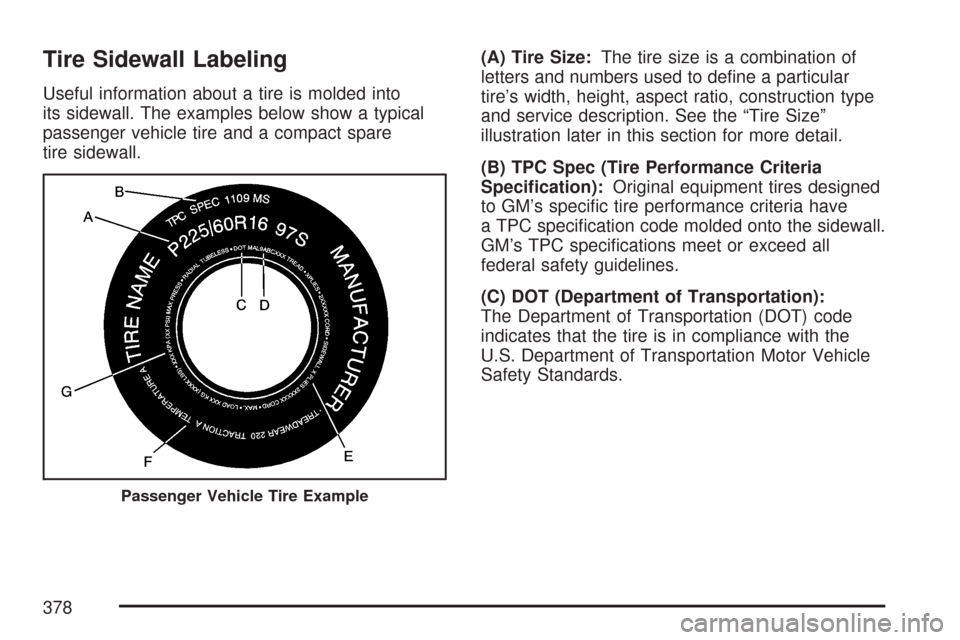
Tire Sidewall Labeling
Useful information about a tire is molded into
its sidewall. The examples below show a typical
passenger vehicle tire and a compact spare
tire sidewall.(A) Tire Size:The tire size is a combination of
letters and numbers used to de�ne a particular
tire’s width, height, aspect ratio, construction type
and service description. See the “Tire Size”
illustration later in this section for more detail.
(B) TPC Spec (Tire Performance Criteria
Speci�cation):Original equipment tires designed
to GM’s speci�c tire performance criteria have
a TPC speci�cation code molded onto the sidewall.
GM’s TPC speci�cations meet or exceed all
federal safety guidelines.
(C) DOT (Department of Transportation):
The Department of Transportation (DOT) code
indicates that the tire is in compliance with the
U.S. Department of Transportation Motor Vehicle
Safety Standards.
Passenger Vehicle Tire Example
378
Page 379 of 496
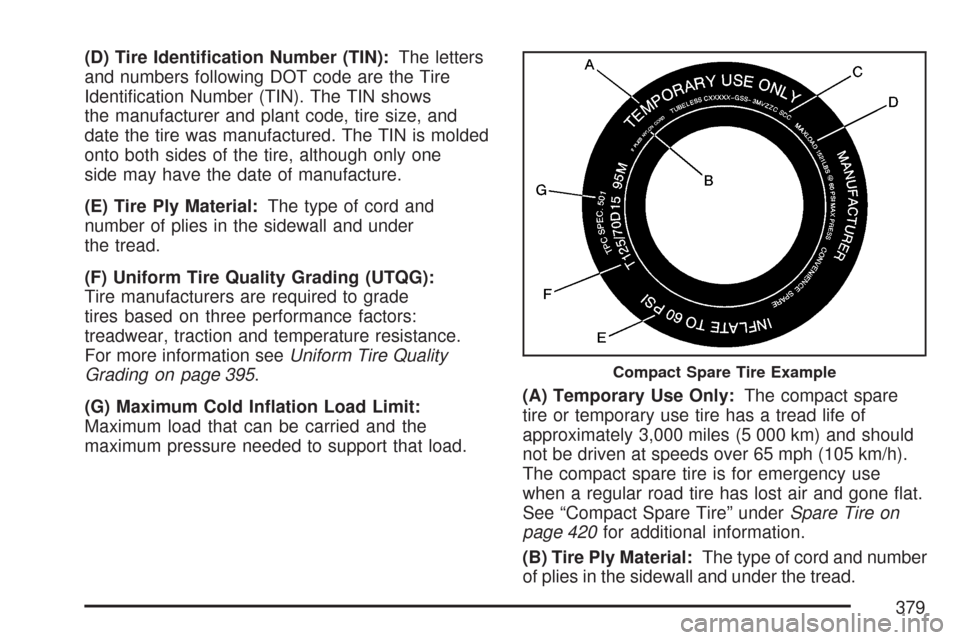
(D) Tire Identi�cation Number (TIN):The letters
and numbers following DOT code are the Tire
Identi�cation Number (TIN). The TIN shows
the manufacturer and plant code, tire size, and
date the tire was manufactured. The TIN is molded
onto both sides of the tire, although only one
side may have the date of manufacture.
(E) Tire Ply Material:The type of cord and
number of plies in the sidewall and under
the tread.
(F) Uniform Tire Quality Grading (UTQG):
Tire manufacturers are required to grade
tires based on three performance factors:
treadwear, traction and temperature resistance.
For more information seeUniform Tire Quality
Grading on page 395.
(G) Maximum Cold In�ation Load Limit:
Maximum load that can be carried and the
maximum pressure needed to support that load.(A) Temporary Use Only:The compact spare
tire or temporary use tire has a tread life of
approximately 3,000 miles (5 000 km) and should
not be driven at speeds over 65 mph (105 km/h).
The compact spare tire is for emergency use
when a regular road tire has lost air and gone �at.
See “Compact Spare Tire” underSpare Tire on
page 420for additional information.
(B) Tire Ply Material:The type of cord and number
of plies in the sidewall and under the tread.
Compact Spare Tire Example
379
Page 380 of 496
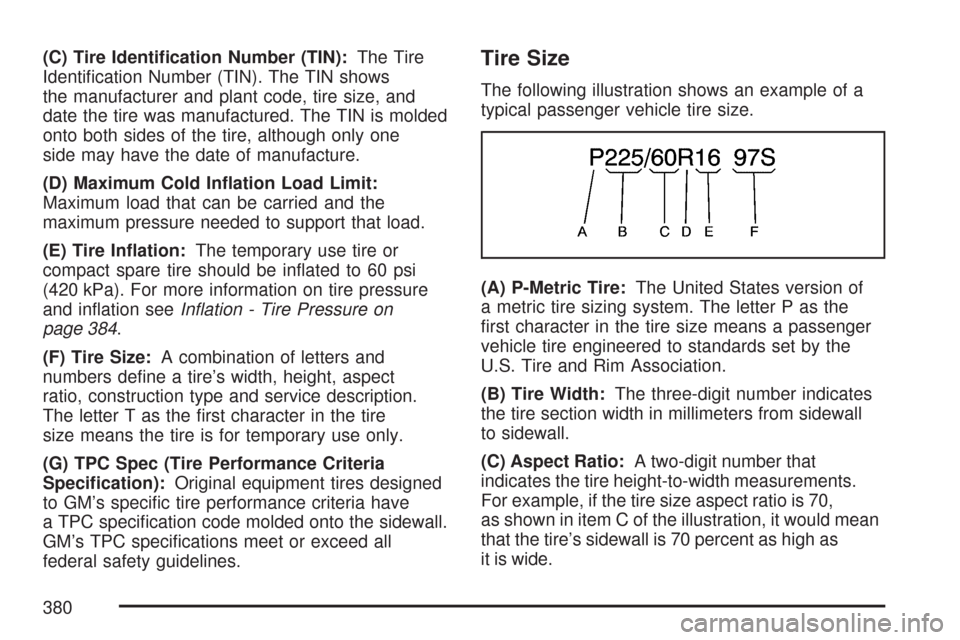
(C) Tire Identi�cation Number (TIN):The Tire
Identi�cation Number (TIN). The TIN shows
the manufacturer and plant code, tire size, and
date the tire was manufactured. The TIN is molded
onto both sides of the tire, although only one
side may have the date of manufacture.
(D) Maximum Cold In�ation Load Limit:
Maximum load that can be carried and the
maximum pressure needed to support that load.
(E) Tire In�ation:The temporary use tire or
compact spare tire should be in�ated to 60 psi
(420 kPa). For more information on tire pressure
and in�ation seeIn�ation - Tire Pressure on
page 384.
(F) Tire Size:A combination of letters and
numbers de�ne a tire’s width, height, aspect
ratio, construction type and service description.
The letter T as the �rst character in the tire
size means the tire is for temporary use only.
(G) TPC Spec (Tire Performance Criteria
Speci�cation):Original equipment tires designed
to GM’s speci�c tire performance criteria have
a TPC speci�cation code molded onto the sidewall.
GM’s TPC speci�cations meet or exceed all
federal safety guidelines.Tire Size
The following illustration shows an example of a
typical passenger vehicle tire size.
(A) P-Metric Tire:The United States version of
a metric tire sizing system. The letter P as the
�rst character in the tire size means a passenger
vehicle tire engineered to standards set by the
U.S. Tire and Rim Association.
(B) Tire Width:The three-digit number indicates
the tire section width in millimeters from sidewall
to sidewall.
(C) Aspect Ratio:A two-digit number that
indicates the tire height-to-width measurements.
For example, if the tire size aspect ratio is 70,
as shown in item C of the illustration, it would mean
that the tire’s sidewall is 70 percent as high as
it is wide.
380